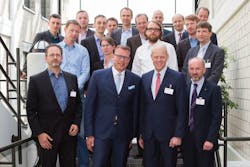
At the recent AKL’18 – International Laser Technology Congress, Reinhart Poprawe, director of the Fraunhofer ILT announced a new Fraunhofer Cluster of Excellence: Advanced Photon Sources: “We line up here with 12 institutes to develop a whole new laser generation for industry and research. We plan for a disruptive technology that will extend the range of applications for laser technology substantially. This ranges from upscaling of ultra-precision manufacturing to opening new pulse width and wavelength ranges for basic research.”
At the Congress he also showed a schedule for the project: Starting with 1 kW and 1 mJ systems in 2018 the collaboration wants to show 5 kW (10 mJ) and 10 kW (1 mJ) in 2020 and, finally, 10 kW (20 mJ) and 20kW (1 mJ) in 2022. In parallel they also plan to improve coherent EUV sources based on high harmonics generation from 1010 photons/s to 1012 photons/s in 2020.
The technology behind these ambitious plans is based on decade-long research efforts in Jena and Aachen. While the team in Aachen has developed an amplification technology based on slabs (which was commercialized by EdgeWave and Amphos), the Jena team specialized in fiber amplifiers and coherent combination technologies.Extreme intensity pulses for a breakthrough in large scale manufacturing
The benefit of USP lasers is their unique intensity. Just for illustration: A pulse with 500 fs length and 1 mJ energy has a peak power of 2 GW. Focused into a spot of 100 µm it creates an intensity of about 20,000 GW/cm². The APS project targets 100 GW pulses with respectively higher intensities. Obviously, these pulses can remove every material instantaneously. And due to their short pulse length they make very clean cuts with adjacent material usually not affected. This capability has already made the USP laser a perfect tool for eye surgery (LASIK) or for glass processing.
While basic research desires even higher powers, the high repetition rate of the new laser systems will enable the upscaling of known processes in industry to much higher throughput. Cutting carbon-fiber reinforced plastics (CFRP) is one well-investigated candidate where the new sources may enable a breakthrough in mass production of lightweight parts for the automotive industry.
Still, basic researchers will love the new devices as well: They currently work with up to ten shots per second in high energy systems. The new kHz and MHz technology could enable systems for USP X-ray generation or smaller particle accelerators, which in turn would spur research in fields such as particle physics, medical physics, or material science.
Process development starts on day one
Certainly, the pure source development plan is very ambitious. At least similarly challenging is the development process technology for such extreme intensity lasers with high average powers. It raises the question, how can this exuberant power be channeled and supplied into carefully controlled applications? Four of the involved Fraunhofer institutes (IOF, ILT, IWS, ISIT) will work on this question from the very beginning of the project.
Ten of the partners will work on applications ranging from production technology to imaging and materials sciences. Examples are micro-structuring of surfaces, surface functionalization of solar cells, and cutting of glass or CFRP. Additional partners may join the cluster in the future.
About the Author
Andreas Thoss
Contributing Editor, Germany
Andreas Thoss is the Managing Director of THOSS Media (Berlin) and has many years of experience in photonics-related research, publishing, marketing, and public relations. He worked with John Wiley & Sons until 2010, when he founded THOSS Media. In 2012, he founded the scientific journal Advanced Optical Technologies. His university research focused on ultrashort and ultra-intense laser pulses, and he holds several patents.

